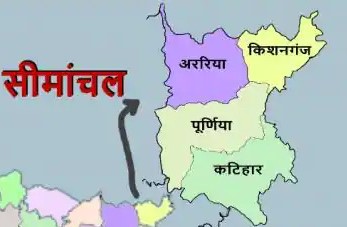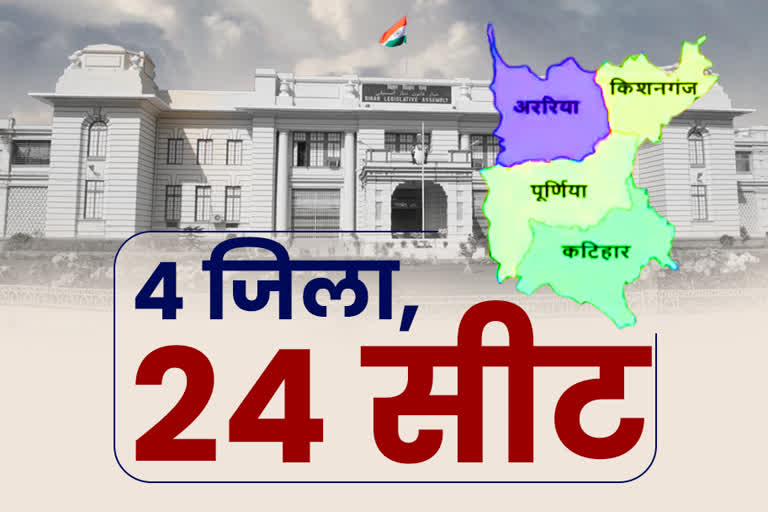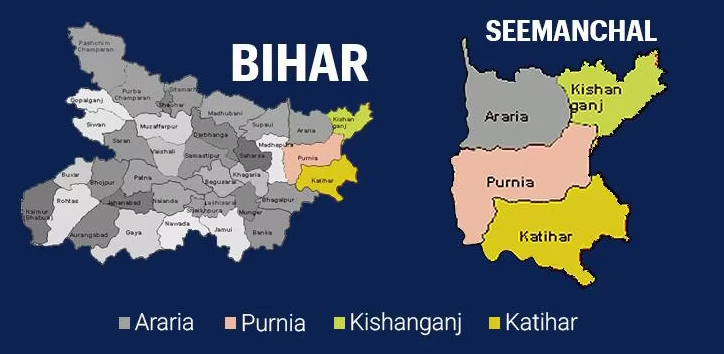Seemanchal, comprising the northeastern Bihar districts of Kishanganj, Araria, Purnia, and Katihar, remains one of the state’s most neglected yet strategically vital regions. With its fertile riverine plains, rich cultural heritage, and proximity to international borders, Seemanchal could be transformed into an economic and geopolitical hub—if only policymakers recognize its untapped potential. The region’s location is its biggest asset: it shares borders with Nepal to the north and is just a short distance from Bangladesh and Bhutan, making it a natural gateway for cross-border trade, cultural exchange, and regional connectivity. Yet, despite this strategic advantage, Seemanchal languishes in underdevelopment, plagued by floods, poor infrastructure, and a lack of industrialization.
The agricultural potential of Seemanchal is immense, with Katihar and Purnia serving as major producers of sugarcane, maize, and mangoes, while Kishanganj’s lush landscapes are ideal for horticulture and organic farming. However, the absence of agro-processing industries means farmers remain trapped in a cycle of low earnings. Meanwhile, the region’s historic jute mills lie in decay, even as global demand for eco-friendly jute products rises. Reviving these industries, along with promoting food processing and handicrafts, could generate thousands of jobs and curb the distress migration of Seemanchal’s youth to distant states.
Beyond agriculture, Seemanchal’s geopolitical significance cannot be overstated. Its proximity to Nepal, Bangladesh, and Bhutan positions it as a critical node in India’s “Act East” policy. Enhanced road and rail links could turn towns like Purnia and Kishanganj into bustling trade centers, facilitating commerce with Nepal’s Biratnagar and Bangladesh’s northern districts. A well-developed Seemanchal could also strengthen India’s cultural diplomacy, given the region’s shared linguistic and ethnic ties with Nepal’s Terai and Bangladesh’s Rajshahi division.

Yet, none of this can happen without urgent government intervention. Flood control measures, 24/7 electricity, and industrial incentives must be prioritized. Skill development centers tailored to regional needs—such as training for agro-industries, textiles, and logistics—can empower the local workforce. Most importantly, policymakers must view Seemanchal not as a peripheral backward zone but as a vital bridge between India and South Asia. If nurtured properly, this long-ignored region could become Bihar’s economic lifeline and a cornerstone of India’s regional trade strategy. The time to act is now—before Seemanchal’s potential is lost to neglect forever.
Economic Potential & Industrial Opportunities
-
Agro-Processing Revolution
-
Establish mega food parks in Purnia and Katihar for processing:
-
Mango pulp/juice units (Kishanganj produces significant proportion of Bihar’s mangoes)
-
Banana chip and flour units
-
Jute diversification products (Katihar was once jute hub)
- GI tag for Seemanchal Makhana
-
-
Create cold storage chains to prevent post-harvest losses
-
-
Textile & Apparel Hub
-
Revive defunct jute mills in Katihar through PPP model
-
Set up handloom clusters for traditional weavers
-
Garment manufacturing units leveraging cheap labor
-
-
Border Trade & Logistics
-
Develop Integrated Check Posts at Nepal border (Forbesganj-Jogbani)
-
Export-oriented units for:
-
Bamboo products (Katihar)
-
Herbal medicines (Kishanganj’s medicinal plants)
-
Meat processing (Halal meat exports to Bangladesh)
-
-
-
Renewable Energy Projects
-
Solar power plants on flood-prone lands
-
Biomass plants using rice husk and sugarcane waste
-
- Infrastructure Push
-
”Seemanchal Expressway” connecting all four districts
-
Completion of pending rail projects (Araria-Forbesganj line)
-
Flood control projects under ”Kosi Revival Mission”Infrastructure Revolution
-
-
Employment Generation
-
-
”One Industry Per District” policy:
-
Food processing in Purnia
-
Jute park in Katihar
-
Herbal medicine cluster in Kishanganj
-
Handicraft export zone in Araria
-
-
Skill development centers for:
-
Agro-technicians
-
Textile machine operators
-
Logistics and warehouse management
-
-
-
Seemanchal: BJP’s Next Frontier for Growth in Bihar
Seemanchal, comprising the districts of Kishanganj, Araria, Purnia, and Katihar, is a region of immense strategic importance for the BJP. Despite its current political challenges, this area presents a golden opportunity for the party to expand its footprint in Bihar. With its unique demographic mix—significant Hindu populations in Purnia and Katihar, and a high Muslim concentration in Kishanganj and Araria—Seemanchal is ripe for the BJP’s development-driven, nationalist agenda. The region’s proximity to Nepal and Bangladesh further enhances its geopolitical significance, making it a potential hub for cross-border trade and cultural diplomacy under a strong, nationalist leadership.
For the BJP, winning Seemanchal is not just about electoral gains; it’s about proving that good governance and inclusive development can triumph over divisive politics. By focusing on infrastructure, job creation, and welfare schemes, the BJP can counter the opposition’s narrative and bring Seemanchal into the mainstream of Bihar’s growth story. The party’s commitment to national security, combined with its emphasis on Hindutva and economic progress, makes it the ideal force to transform this neglected region into a model of prosperity and social harmony.

The Road Ahead: A BJP-Led Transformation
Seemanchal’s future lies in the BJP’s ability to blend development with cultural pride. By delivering on promises and countering anti-national forces, the party can turn this region into a shining example of “Sabka Saath, Sabka Vikas, Sabka Vishwas.” The time for Seemanchal’s resurgence is now—and the BJP is the only party with the vision and will to make it happen.
